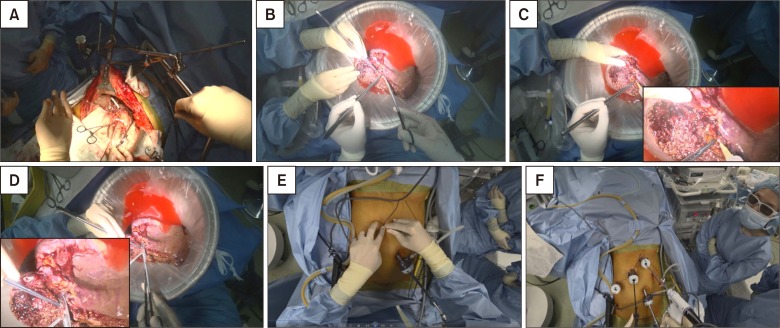Ann Hepatobiliary Pancreat Surg.
2020 Feb;24(1):38-43. 10.14701/ahbps.2020.24.1.38.
Wearable recording video technology for surgical training in living donor liver transplantation
- Affiliations
-
- 1Department of Surgery, Seoul National University College of Medicine, Seoul, Korea. lulu5050@naver.com
- KMID: 2471187
- DOI: http://doi.org/10.14701/ahbps.2020.24.1.38
Abstract
- BACKGROUNDS/AIMS
As the development of surgical video recording technologies, educational videos have become widely utilized for trainee education. However, the current forms of surgical video are limited because they do not show all the roles of the participants. Aim of this study is to make optimal training material about living donor liver transplantation for residents and fellows using wearable recording system.
METHODS
Three video clips about procedure of liver transplantation were made. A head mount was used to fix the camera on the surgeon or assistant's head. Anastomosis of vessels, bench operation and trocar insertion for laparoscopic donor hepatectomy were recorded. Each video clips were edited including indicators, subtitles, and narration. The edited videos were shown to 20 General Surgery trainees (18 residents, 2 fellows) and we received feedback. The results of the questionnaire were quantitatively analyzed to show how efficient and informative it is compared to existing educational materials.
RESULTS
Sixteen of the 20 trainees (80%) responded that this video helped them improve their surgical skills. Eighteen trainees (90%) responded that they gained new knowledge through this video. Sixteen trainees (80%) responded that the action camera image material was more educational than existing text-based and video-based materials, with an average score of 8.5 and 6.5 (action camera materials vs. text-based materials, respectively).
CONCLUSIONS
A head-mounted action camera video recording system is a good model for making high-quality educational video modules and can be a useful teaching tool for living donor liver transplantation.
Keyword
MeSH Terms
Figure
Reference
-
1. Moore MD, Abelson JS, O'Mahoney P, Bagautdinov I, Yeo H, Watkins AC. Using GoPro to give video-assisted operative feedback for surgery residents: a feasibility and utility assessment. J Surg Educ. 2018; 75:497–502. PMID: 28838833.
Article2. Ganry L, Sigaux N, Ettinger KS, Salman SO, Fernandes RP. Modified GoPro Hero 6 and 7 for intraoperative surgical recording-transformation into a surgeon-perspective professional quality recording system. J Oral Maxillofac Surg. 2019; 77:1703.e1–1703.e6. PMID: 31009633.
Article3. Ortensi A, Panunzi A, Trombetta S, Cattaneo A, Sorrenti S, D'Orazi V. Advancement of thyroid surgery video recording: a comparison between two full HD head mounted video cameras. Int J Surg. 2017; 41 Suppl 1:S65–S69. PMID: 28506416.
Article4. Singh P, Aggarwal R, Tahir M, Pucher PH, Darzi A. A randomized controlled study to evaluate the role of video-based coaching in training laparoscopic skills. Ann Surg. 2015; 261:862–869. PMID: 25185469.
Article5. Jensen AR, Wright AS, Kim S, Horvath KD, Calhoun KE. Educational feedback in the operating room: a gap between resident and faculty perceptions. Am J Surg. 2012; 204:248–255. PMID: 22537472.
Article6. Nair AG, Kamal S, Dave TV, Mishra K, Reddy HS, Della Rocca D, et al. Surgeon point-of-view recording: Using a high-definition head-mounted video camera in the operating room. Indian J Ophthalmol. 2015; 63:771–774. PMID: 26655001.
Article7. Bonrath EM, Dedy NJ, Gordon LE, Grantcharov TP. Compr ehensive surgical coaching enhances surgical skill in the operating room: a randomized controlled trial. Ann Surg. 2015; 262:205–212. PMID: 25822691.8. Lee JM, Shehta A, Suh KS, Hong SK, Yoon KC, Cho JH, et al. Guidance for optimal port placement in pure 3-Dimensional laparoscopic donor right hepatectomy. Liver Transpl. 2019; 25:1714–1722. PMID: 31348587.
Article9. Ahmet A, Gamze K, Rustem M, Sezen KA. Is video-based education an effective method in surgical education? A systematic review. J Surg Educ. 2018; 75:1150–1158. PMID: 29449162.
Article
- Full Text Links
- Actions
-
Cited
- CITED
-
- Close
- Share
- Similar articles
-
- Liver retransplantation for adult recipients
- Minimal-incision donor right hepatectomy for living donor liver transplantation
- Unilateral Versus Bilateral Biliary Drainage for Post-Transplant Anastomotic Stricture
- Left at right heterotopic implantation of left liver graft in adult-to-adult living donor liver transplantation: the technical concern for decision-making
- Endoscopic management of anastomotic stricture after living-donor liver transplantation



